BMP3004 - Motivation: Factors, Experiences and Coping Strategies
VerifiedAdded on 2023/06/18
|8
|1927
|296
Report
AI Summary
This report explores the multifaceted nature of employee motivation, emphasizing its significance in enhancing organizational effectiveness. It delves into various motivation theories, including Maslow's hierarchy of needs, and differentiates between intrinsic and extrinsic motivation. The report identifies salary, promotion opportunities, and a positive work environment as key motivators, while workplace conflicts and toxic environments are highlighted as negative influences. Strategies for mitigating these negative factors, such as fostering open communication, providing recognition, and promoting employee engagement, are also discussed. Ultimately, the report underscores the importance of understanding and addressing motivational factors to create a productive and fulfilling work environment. Desklib provides access to similar reports and study resources for students.
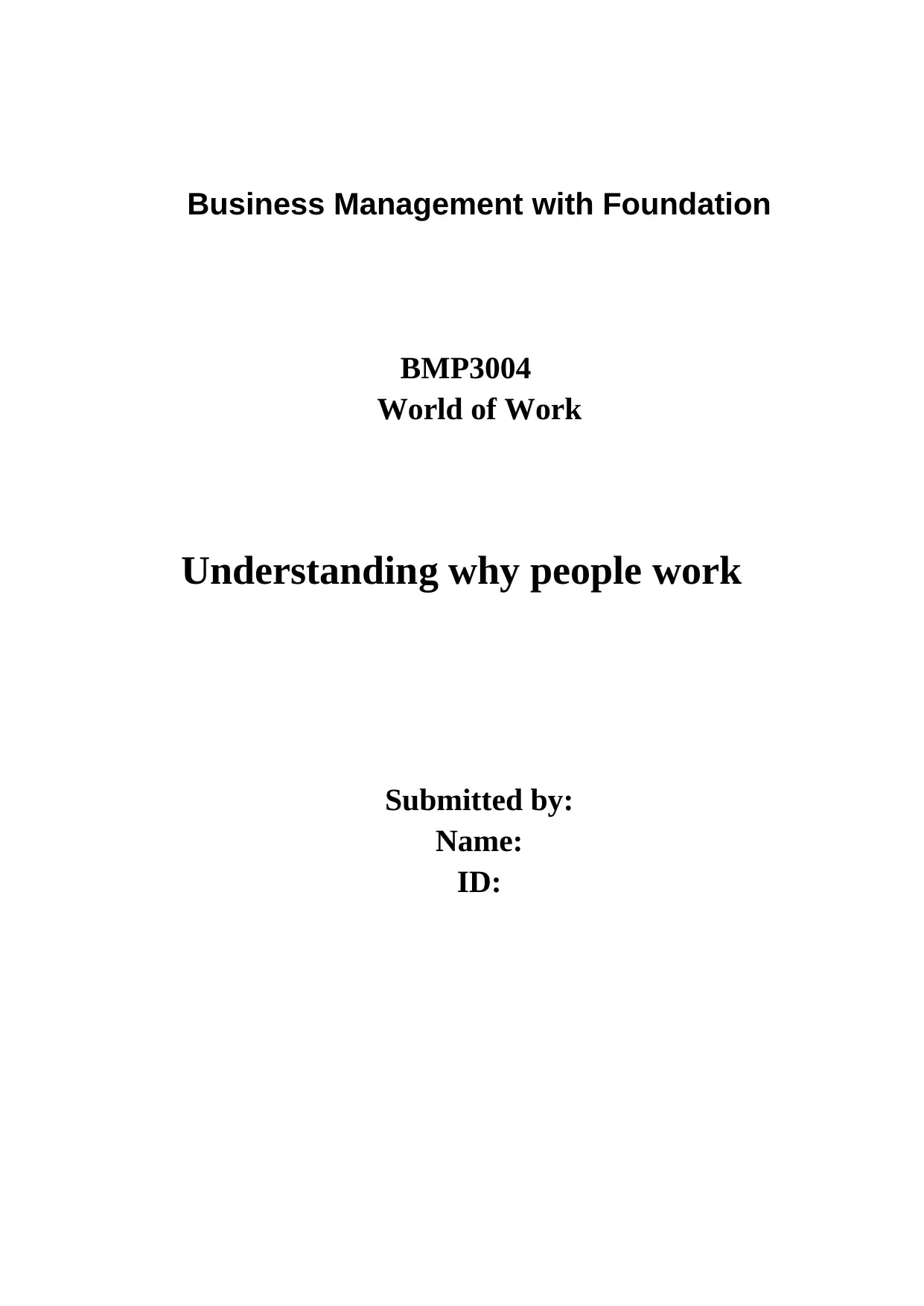
Business Management with Foundation
BMP3004
World of Work
Understanding why people work
Submitted by:
Name:
ID:
BMP3004
World of Work
Understanding why people work
Submitted by:
Name:
ID:
Paraphrase This Document
Need a fresh take? Get an instant paraphrase of this document with our AI Paraphraser
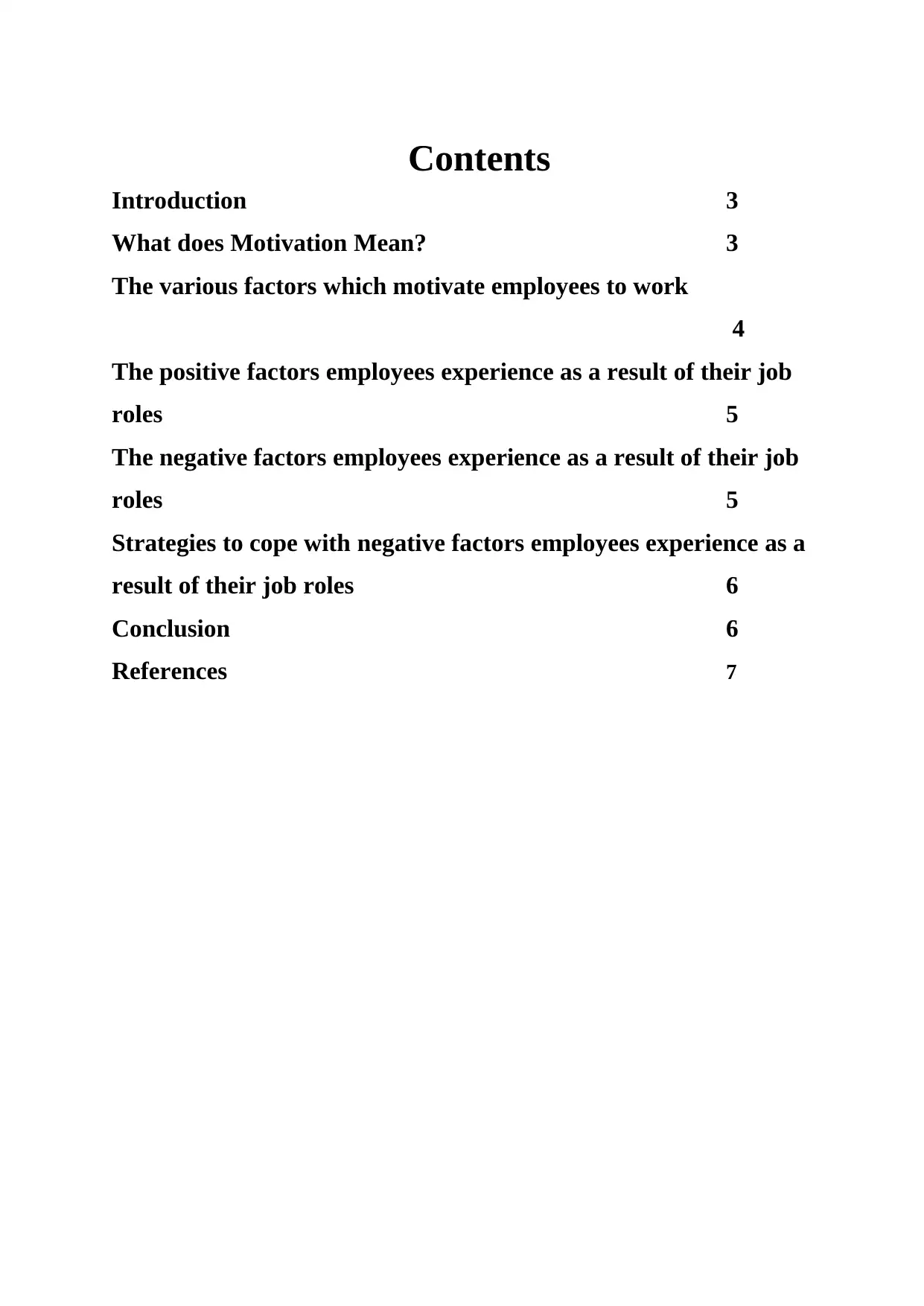
Contents
Introduction 3
What does Motivation Mean? 3
The various factors which motivate employees to work
4
The positive factors employees experience as a result of their job
roles 5
The negative factors employees experience as a result of their job
roles 5
Strategies to cope with negative factors employees experience as a
result of their job roles 6
Conclusion 6
References 7
Introduction 3
What does Motivation Mean? 3
The various factors which motivate employees to work
4
The positive factors employees experience as a result of their job
roles 5
The negative factors employees experience as a result of their job
roles 5
Strategies to cope with negative factors employees experience as a
result of their job roles 6
Conclusion 6
References 7
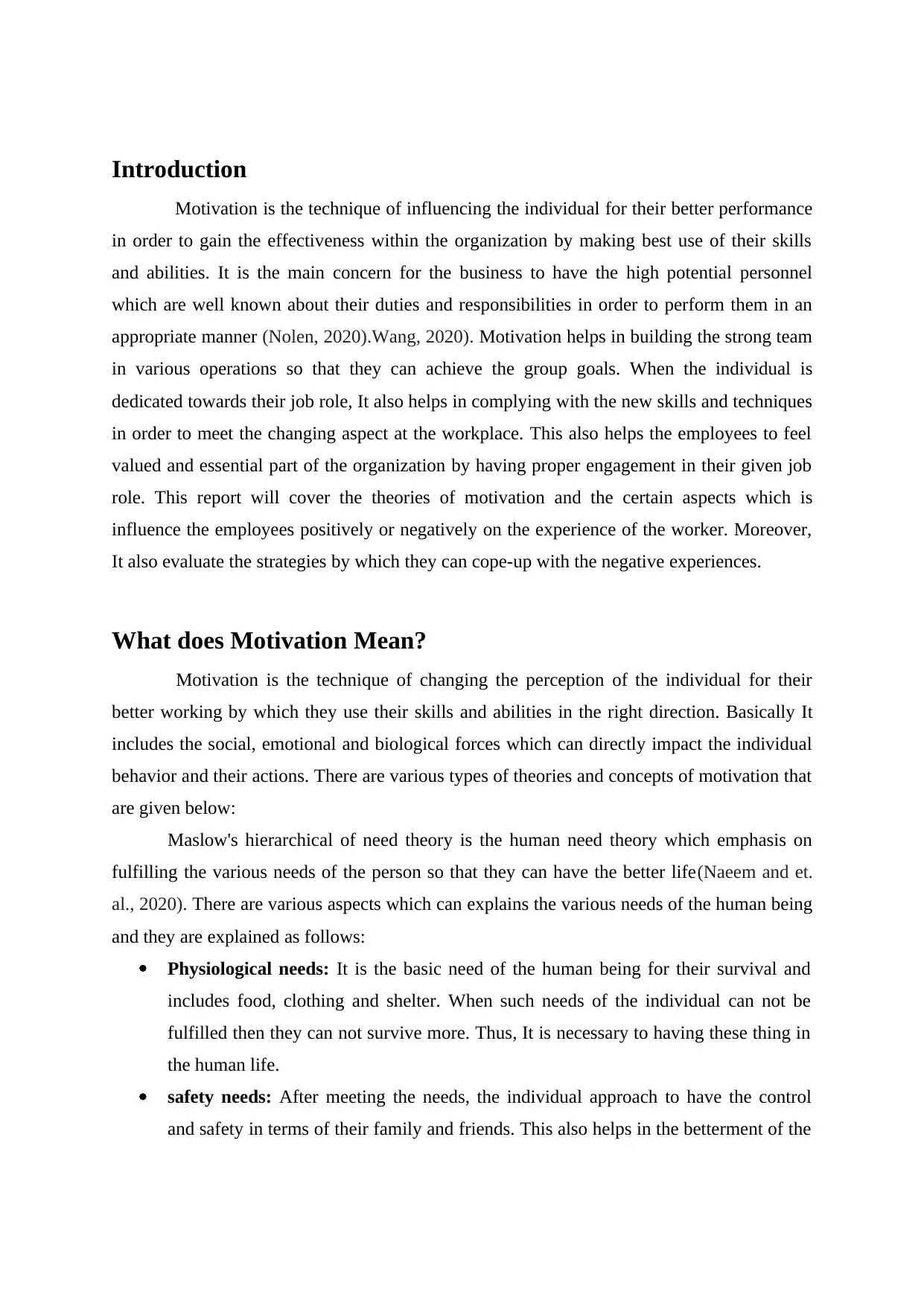
Introduction
Motivation is the technique of influencing the individual for their better performance
in order to gain the effectiveness within the organization by making best use of their skills
and abilities. It is the main concern for the business to have the high potential personnel
which are well known about their duties and responsibilities in order to perform them in an
appropriate manner (Nolen, 2020).Wang, 2020). Motivation helps in building the strong team
in various operations so that they can achieve the group goals. When the individual is
dedicated towards their job role, It also helps in complying with the new skills and techniques
in order to meet the changing aspect at the workplace. This also helps the employees to feel
valued and essential part of the organization by having proper engagement in their given job
role. This report will cover the theories of motivation and the certain aspects which is
influence the employees positively or negatively on the experience of the worker. Moreover,
It also evaluate the strategies by which they can cope-up with the negative experiences.
What does Motivation Mean?
Motivation is the technique of changing the perception of the individual for their
better working by which they use their skills and abilities in the right direction. Basically It
includes the social, emotional and biological forces which can directly impact the individual
behavior and their actions. There are various types of theories and concepts of motivation that
are given below:
Maslow's hierarchical of need theory is the human need theory which emphasis on
fulfilling the various needs of the person so that they can have the better life(Naeem and et.
al., 2020). There are various aspects which can explains the various needs of the human being
and they are explained as follows:
Physiological needs: It is the basic need of the human being for their survival and
includes food, clothing and shelter. When such needs of the individual can not be
fulfilled then they can not survive more. Thus, It is necessary to having these thing in
the human life.
safety needs: After meeting the needs, the individual approach to have the control
and safety in terms of their family and friends. This also helps in the betterment of the
Motivation is the technique of influencing the individual for their better performance
in order to gain the effectiveness within the organization by making best use of their skills
and abilities. It is the main concern for the business to have the high potential personnel
which are well known about their duties and responsibilities in order to perform them in an
appropriate manner (Nolen, 2020).Wang, 2020). Motivation helps in building the strong team
in various operations so that they can achieve the group goals. When the individual is
dedicated towards their job role, It also helps in complying with the new skills and techniques
in order to meet the changing aspect at the workplace. This also helps the employees to feel
valued and essential part of the organization by having proper engagement in their given job
role. This report will cover the theories of motivation and the certain aspects which is
influence the employees positively or negatively on the experience of the worker. Moreover,
It also evaluate the strategies by which they can cope-up with the negative experiences.
What does Motivation Mean?
Motivation is the technique of changing the perception of the individual for their
better working by which they use their skills and abilities in the right direction. Basically It
includes the social, emotional and biological forces which can directly impact the individual
behavior and their actions. There are various types of theories and concepts of motivation that
are given below:
Maslow's hierarchical of need theory is the human need theory which emphasis on
fulfilling the various needs of the person so that they can have the better life(Naeem and et.
al., 2020). There are various aspects which can explains the various needs of the human being
and they are explained as follows:
Physiological needs: It is the basic need of the human being for their survival and
includes food, clothing and shelter. When such needs of the individual can not be
fulfilled then they can not survive more. Thus, It is necessary to having these thing in
the human life.
safety needs: After meeting the needs, the individual approach to have the control
and safety in terms of their family and friends. This also helps in the betterment of the
⊘ This is a preview!⊘
Do you want full access?
Subscribe today to unlock all pages.

Trusted by 1+ million students worldwide
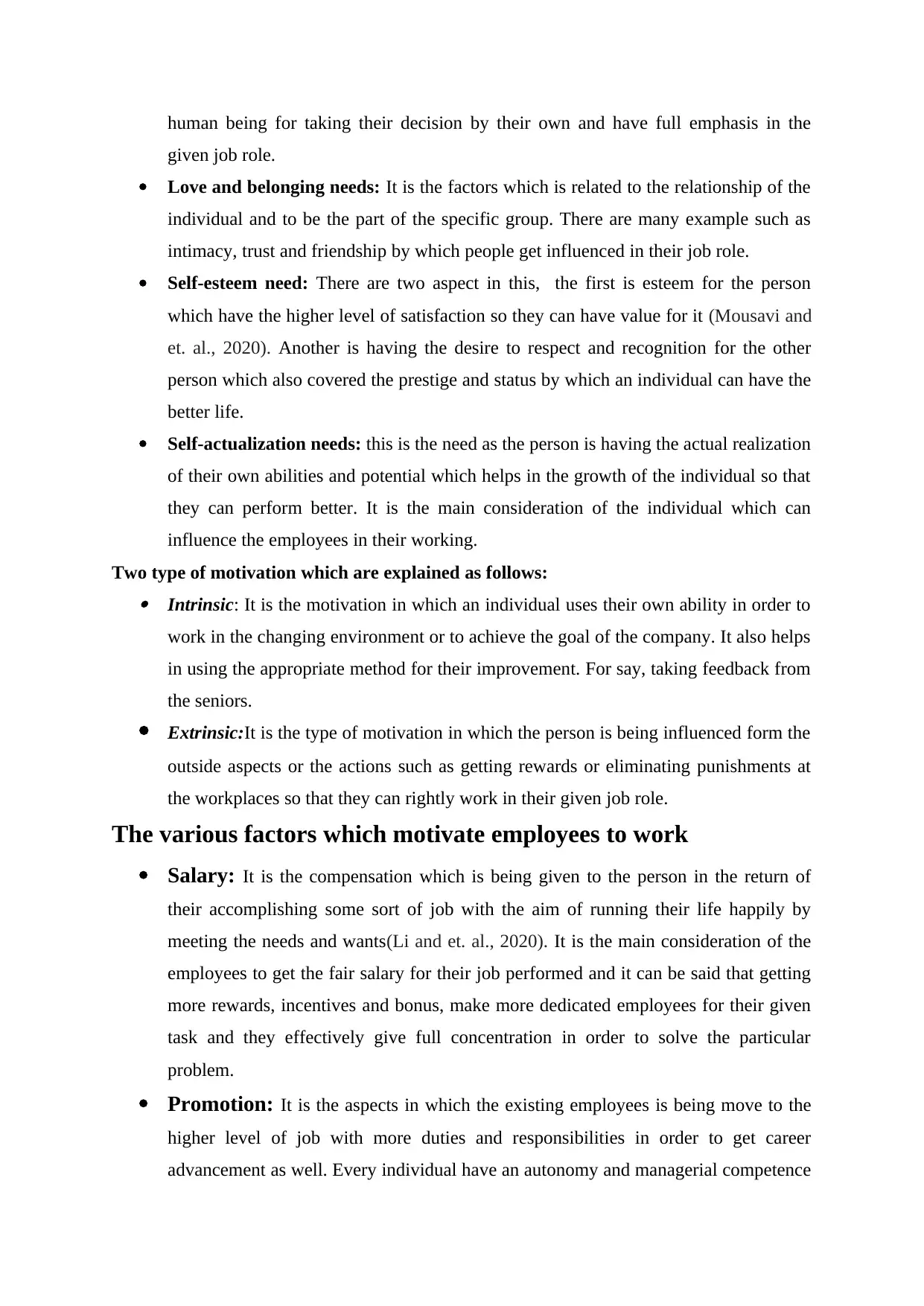
human being for taking their decision by their own and have full emphasis in the
given job role.
Love and belonging needs: It is the factors which is related to the relationship of the
individual and to be the part of the specific group. There are many example such as
intimacy, trust and friendship by which people get influenced in their job role.
Self-esteem need: There are two aspect in this, the first is esteem for the person
which have the higher level of satisfaction so they can have value for it (Mousavi and
et. al., 2020). Another is having the desire to respect and recognition for the other
person which also covered the prestige and status by which an individual can have the
better life.
Self-actualization needs: this is the need as the person is having the actual realization
of their own abilities and potential which helps in the growth of the individual so that
they can perform better. It is the main consideration of the individual which can
influence the employees in their working.
Two type of motivation which are explained as follows: Intrinsic: It is the motivation in which an individual uses their own ability in order to
work in the changing environment or to achieve the goal of the company. It also helps
in using the appropriate method for their improvement. For say, taking feedback from
the seniors.
Extrinsic:It is the type of motivation in which the person is being influenced form the
outside aspects or the actions such as getting rewards or eliminating punishments at
the workplaces so that they can rightly work in their given job role.
The various factors which motivate employees to work
Salary: It is the compensation which is being given to the person in the return of
their accomplishing some sort of job with the aim of running their life happily by
meeting the needs and wants(Li and et. al., 2020). It is the main consideration of the
employees to get the fair salary for their job performed and it can be said that getting
more rewards, incentives and bonus, make more dedicated employees for their given
task and they effectively give full concentration in order to solve the particular
problem.
Promotion: It is the aspects in which the existing employees is being move to the
higher level of job with more duties and responsibilities in order to get career
advancement as well. Every individual have an autonomy and managerial competence
given job role.
Love and belonging needs: It is the factors which is related to the relationship of the
individual and to be the part of the specific group. There are many example such as
intimacy, trust and friendship by which people get influenced in their job role.
Self-esteem need: There are two aspect in this, the first is esteem for the person
which have the higher level of satisfaction so they can have value for it (Mousavi and
et. al., 2020). Another is having the desire to respect and recognition for the other
person which also covered the prestige and status by which an individual can have the
better life.
Self-actualization needs: this is the need as the person is having the actual realization
of their own abilities and potential which helps in the growth of the individual so that
they can perform better. It is the main consideration of the individual which can
influence the employees in their working.
Two type of motivation which are explained as follows: Intrinsic: It is the motivation in which an individual uses their own ability in order to
work in the changing environment or to achieve the goal of the company. It also helps
in using the appropriate method for their improvement. For say, taking feedback from
the seniors.
Extrinsic:It is the type of motivation in which the person is being influenced form the
outside aspects or the actions such as getting rewards or eliminating punishments at
the workplaces so that they can rightly work in their given job role.
The various factors which motivate employees to work
Salary: It is the compensation which is being given to the person in the return of
their accomplishing some sort of job with the aim of running their life happily by
meeting the needs and wants(Li and et. al., 2020). It is the main consideration of the
employees to get the fair salary for their job performed and it can be said that getting
more rewards, incentives and bonus, make more dedicated employees for their given
task and they effectively give full concentration in order to solve the particular
problem.
Promotion: It is the aspects in which the existing employees is being move to the
higher level of job with more duties and responsibilities in order to get career
advancement as well. Every individual have an autonomy and managerial competence
Paraphrase This Document
Need a fresh take? Get an instant paraphrase of this document with our AI Paraphraser
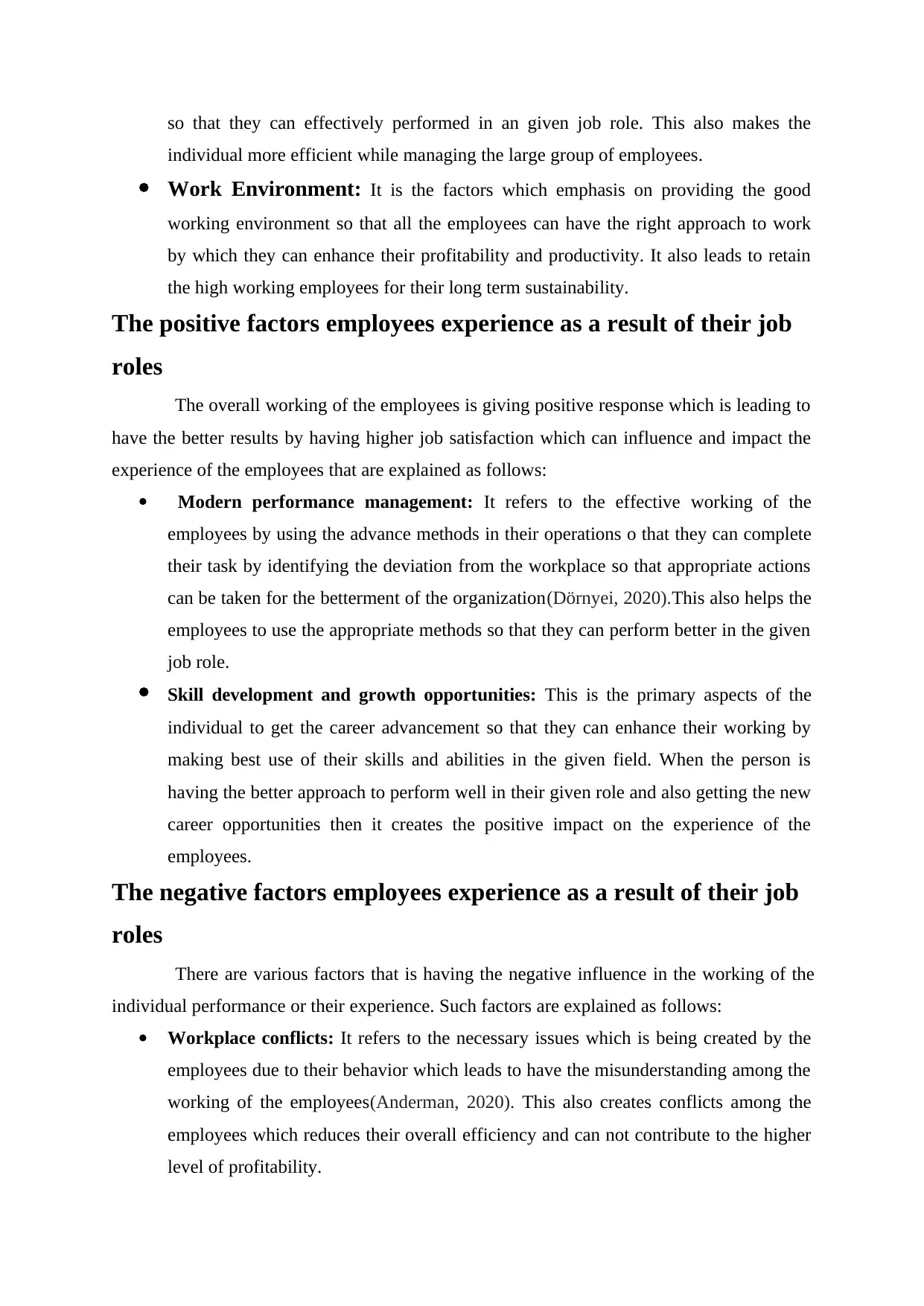
so that they can effectively performed in an given job role. This also makes the
individual more efficient while managing the large group of employees.
Work Environment: It is the factors which emphasis on providing the good
working environment so that all the employees can have the right approach to work
by which they can enhance their profitability and productivity. It also leads to retain
the high working employees for their long term sustainability.
The positive factors employees experience as a result of their job
roles
The overall working of the employees is giving positive response which is leading to
have the better results by having higher job satisfaction which can influence and impact the
experience of the employees that are explained as follows:
Modern performance management: It refers to the effective working of the
employees by using the advance methods in their operations o that they can complete
their task by identifying the deviation from the workplace so that appropriate actions
can be taken for the betterment of the organization(Dörnyei, 2020).This also helps the
employees to use the appropriate methods so that they can perform better in the given
job role.
Skill development and growth opportunities: This is the primary aspects of the
individual to get the career advancement so that they can enhance their working by
making best use of their skills and abilities in the given field. When the person is
having the better approach to perform well in their given role and also getting the new
career opportunities then it creates the positive impact on the experience of the
employees.
The negative factors employees experience as a result of their job
roles
There are various factors that is having the negative influence in the working of the
individual performance or their experience. Such factors are explained as follows:
Workplace conflicts: It refers to the necessary issues which is being created by the
employees due to their behavior which leads to have the misunderstanding among the
working of the employees(Anderman, 2020). This also creates conflicts among the
employees which reduces their overall efficiency and can not contribute to the higher
level of profitability.
individual more efficient while managing the large group of employees.
Work Environment: It is the factors which emphasis on providing the good
working environment so that all the employees can have the right approach to work
by which they can enhance their profitability and productivity. It also leads to retain
the high working employees for their long term sustainability.
The positive factors employees experience as a result of their job
roles
The overall working of the employees is giving positive response which is leading to
have the better results by having higher job satisfaction which can influence and impact the
experience of the employees that are explained as follows:
Modern performance management: It refers to the effective working of the
employees by using the advance methods in their operations o that they can complete
their task by identifying the deviation from the workplace so that appropriate actions
can be taken for the betterment of the organization(Dörnyei, 2020).This also helps the
employees to use the appropriate methods so that they can perform better in the given
job role.
Skill development and growth opportunities: This is the primary aspects of the
individual to get the career advancement so that they can enhance their working by
making best use of their skills and abilities in the given field. When the person is
having the better approach to perform well in their given role and also getting the new
career opportunities then it creates the positive impact on the experience of the
employees.
The negative factors employees experience as a result of their job
roles
There are various factors that is having the negative influence in the working of the
individual performance or their experience. Such factors are explained as follows:
Workplace conflicts: It refers to the necessary issues which is being created by the
employees due to their behavior which leads to have the misunderstanding among the
working of the employees(Anderman, 2020). This also creates conflicts among the
employees which reduces their overall efficiency and can not contribute to the higher
level of profitability.
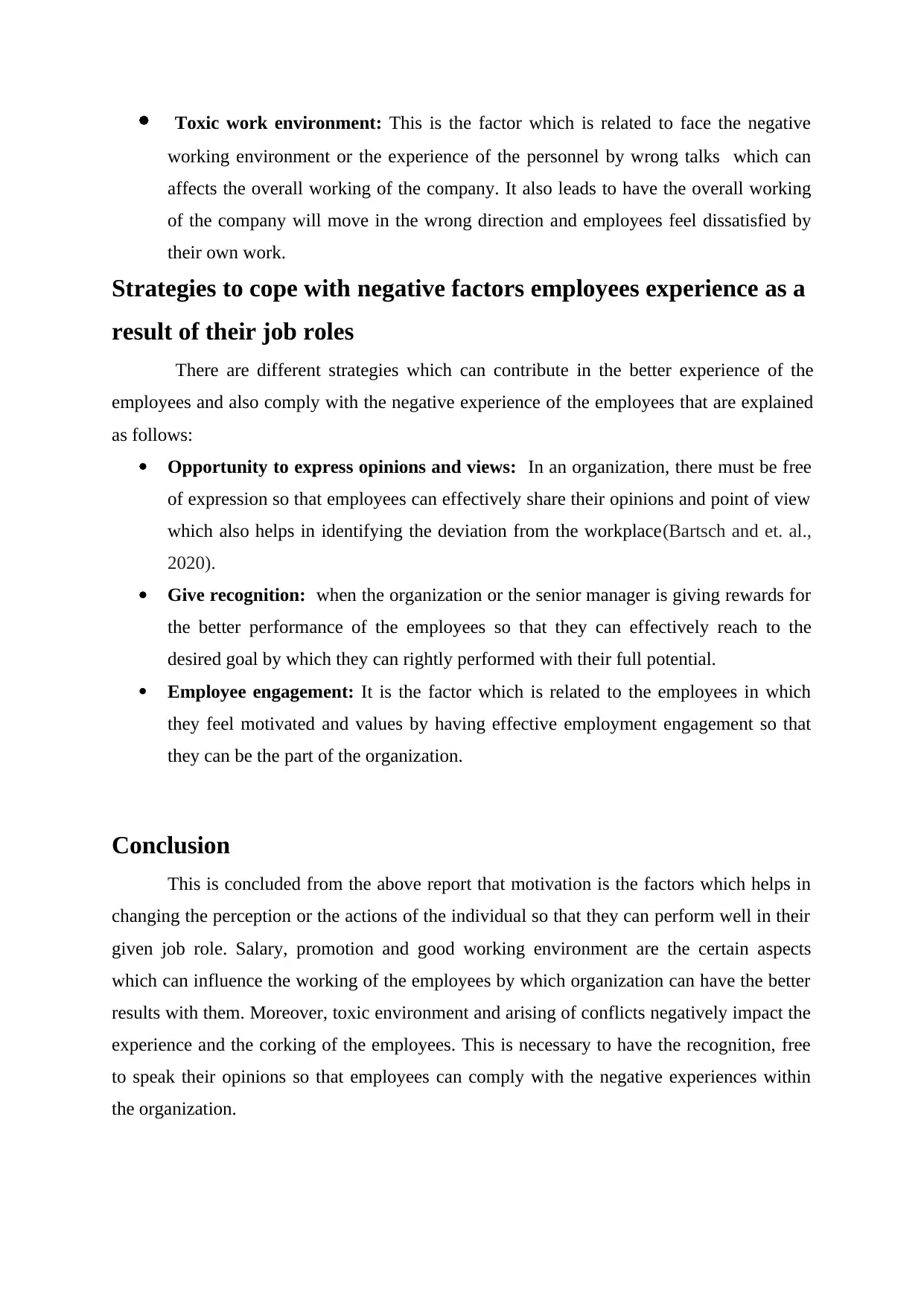
Toxic work environment: This is the factor which is related to face the negative
working environment or the experience of the personnel by wrong talks which can
affects the overall working of the company. It also leads to have the overall working
of the company will move in the wrong direction and employees feel dissatisfied by
their own work.
Strategies to cope with negative factors employees experience as a
result of their job roles
There are different strategies which can contribute in the better experience of the
employees and also comply with the negative experience of the employees that are explained
as follows:
Opportunity to express opinions and views: In an organization, there must be free
of expression so that employees can effectively share their opinions and point of view
which also helps in identifying the deviation from the workplace(Bartsch and et. al.,
2020).
Give recognition: when the organization or the senior manager is giving rewards for
the better performance of the employees so that they can effectively reach to the
desired goal by which they can rightly performed with their full potential.
Employee engagement: It is the factor which is related to the employees in which
they feel motivated and values by having effective employment engagement so that
they can be the part of the organization.
Conclusion
This is concluded from the above report that motivation is the factors which helps in
changing the perception or the actions of the individual so that they can perform well in their
given job role. Salary, promotion and good working environment are the certain aspects
which can influence the working of the employees by which organization can have the better
results with them. Moreover, toxic environment and arising of conflicts negatively impact the
experience and the corking of the employees. This is necessary to have the recognition, free
to speak their opinions so that employees can comply with the negative experiences within
the organization.
working environment or the experience of the personnel by wrong talks which can
affects the overall working of the company. It also leads to have the overall working
of the company will move in the wrong direction and employees feel dissatisfied by
their own work.
Strategies to cope with negative factors employees experience as a
result of their job roles
There are different strategies which can contribute in the better experience of the
employees and also comply with the negative experience of the employees that are explained
as follows:
Opportunity to express opinions and views: In an organization, there must be free
of expression so that employees can effectively share their opinions and point of view
which also helps in identifying the deviation from the workplace(Bartsch and et. al.,
2020).
Give recognition: when the organization or the senior manager is giving rewards for
the better performance of the employees so that they can effectively reach to the
desired goal by which they can rightly performed with their full potential.
Employee engagement: It is the factor which is related to the employees in which
they feel motivated and values by having effective employment engagement so that
they can be the part of the organization.
Conclusion
This is concluded from the above report that motivation is the factors which helps in
changing the perception or the actions of the individual so that they can perform well in their
given job role. Salary, promotion and good working environment are the certain aspects
which can influence the working of the employees by which organization can have the better
results with them. Moreover, toxic environment and arising of conflicts negatively impact the
experience and the corking of the employees. This is necessary to have the recognition, free
to speak their opinions so that employees can comply with the negative experiences within
the organization.
⊘ This is a preview!⊘
Do you want full access?
Subscribe today to unlock all pages.

Trusted by 1+ million students worldwide

Paraphrase This Document
Need a fresh take? Get an instant paraphrase of this document with our AI Paraphraser
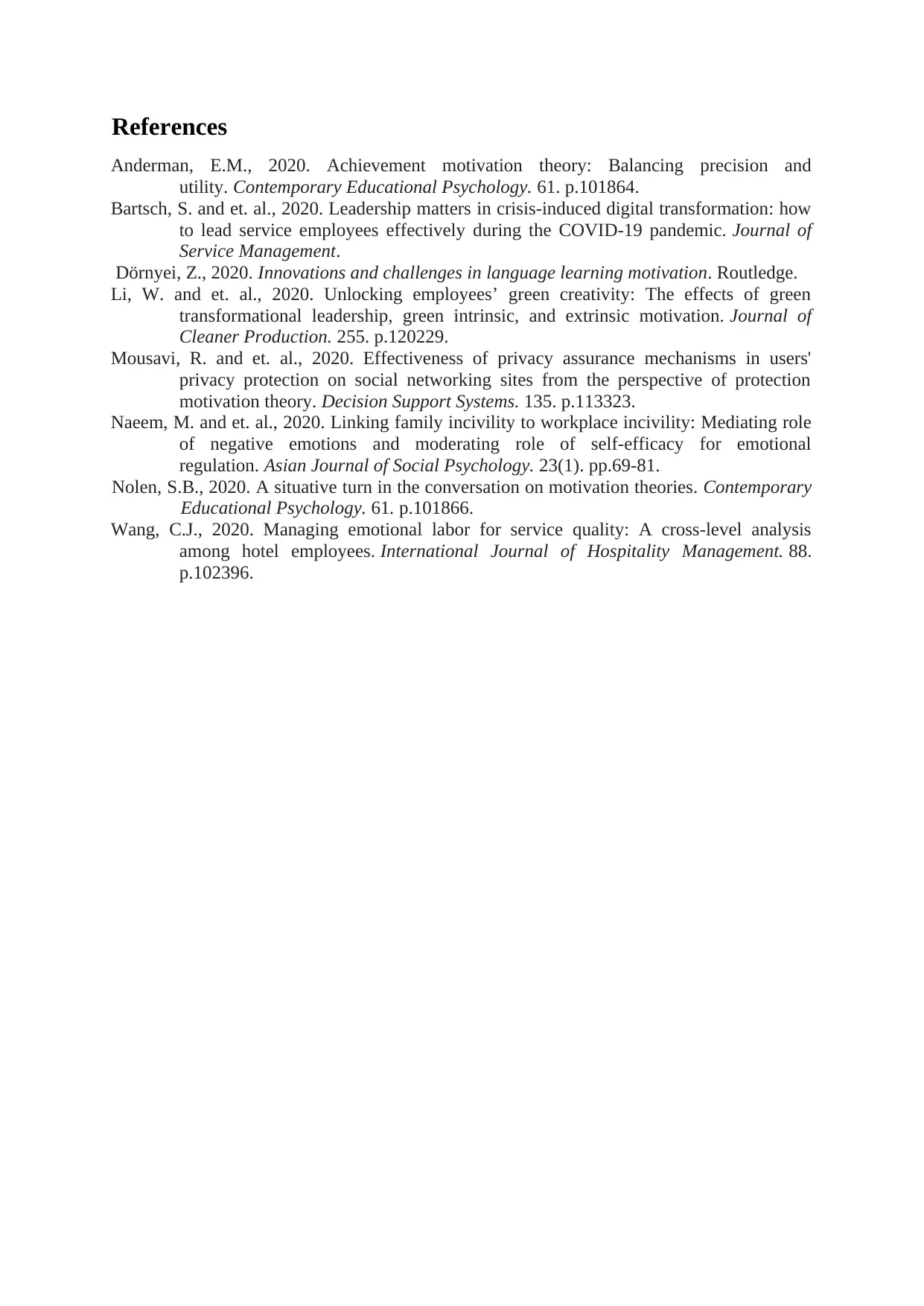
References
Anderman, E.M., 2020. Achievement motivation theory: Balancing precision and
utility. Contemporary Educational Psychology. 61. p.101864.
Bartsch, S. and et. al., 2020. Leadership matters in crisis-induced digital transformation: how
to lead service employees effectively during the COVID-19 pandemic. Journal of
Service Management.
Dörnyei, Z., 2020. Innovations and challenges in language learning motivation. Routledge.
Li, W. and et. al., 2020. Unlocking employees’ green creativity: The effects of green
transformational leadership, green intrinsic, and extrinsic motivation. Journal of
Cleaner Production. 255. p.120229.
Mousavi, R. and et. al., 2020. Effectiveness of privacy assurance mechanisms in users'
privacy protection on social networking sites from the perspective of protection
motivation theory. Decision Support Systems. 135. p.113323.
Naeem, M. and et. al., 2020. Linking family incivility to workplace incivility: Mediating role
of negative emotions and moderating role of self‐efficacy for emotional
regulation. Asian Journal of Social Psychology. 23(1). pp.69-81.
Nolen, S.B., 2020. A situative turn in the conversation on motivation theories. Contemporary
Educational Psychology. 61. p.101866.
Wang, C.J., 2020. Managing emotional labor for service quality: A cross-level analysis
among hotel employees. International Journal of Hospitality Management. 88.
p.102396.
Anderman, E.M., 2020. Achievement motivation theory: Balancing precision and
utility. Contemporary Educational Psychology. 61. p.101864.
Bartsch, S. and et. al., 2020. Leadership matters in crisis-induced digital transformation: how
to lead service employees effectively during the COVID-19 pandemic. Journal of
Service Management.
Dörnyei, Z., 2020. Innovations and challenges in language learning motivation. Routledge.
Li, W. and et. al., 2020. Unlocking employees’ green creativity: The effects of green
transformational leadership, green intrinsic, and extrinsic motivation. Journal of
Cleaner Production. 255. p.120229.
Mousavi, R. and et. al., 2020. Effectiveness of privacy assurance mechanisms in users'
privacy protection on social networking sites from the perspective of protection
motivation theory. Decision Support Systems. 135. p.113323.
Naeem, M. and et. al., 2020. Linking family incivility to workplace incivility: Mediating role
of negative emotions and moderating role of self‐efficacy for emotional
regulation. Asian Journal of Social Psychology. 23(1). pp.69-81.
Nolen, S.B., 2020. A situative turn in the conversation on motivation theories. Contemporary
Educational Psychology. 61. p.101866.
Wang, C.J., 2020. Managing emotional labor for service quality: A cross-level analysis
among hotel employees. International Journal of Hospitality Management. 88.
p.102396.
1 out of 8
Related Documents
Your All-in-One AI-Powered Toolkit for Academic Success.
+13062052269
info@desklib.com
Available 24*7 on WhatsApp / Email
![[object Object]](/_next/static/media/star-bottom.7253800d.svg)
Unlock your academic potential
Copyright © 2020–2025 A2Z Services. All Rights Reserved. Developed and managed by ZUCOL.


